

Human Self. Pax Humanitas. Declaration on the Relation of the Church to non-christian religions - Nostra Aetate. 1.
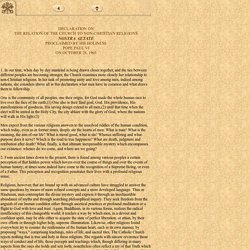
In our time, when day by day mankind is being drawn closer together, and the ties between different peoples are becoming stronger, the Church examines more closely her relationship to non-Christian religions. In her task of promoting unity and love among men, indeed among nations, she considers above all in this declaration what men have in common and what draws them to fellowship. Altered States. Transcendence. संस्कृतम् Mythos. Natura Mythica Deios. Left Hand of Darkness. Spirits Align. Singula. The Ka. Reincarnation. Reincarnation is the religious or philosophical concept that the soul or spirit, after biological death, begins a new life in a new body that may be human, animal or spiritual depending on the moral quality of the previous life's actions.
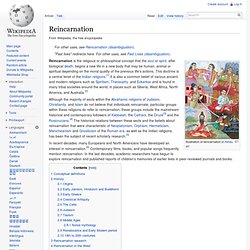
This doctrine is a central tenet of the Indian religions.[1] It is also a common belief of various ancient and modern religions such as Spiritism, Theosophy, and Eckankar and is found in many tribal societies around the world, in places such as Siberia, West Africa, North America, and Australia.[2] In recent decades, many Europeans and North Americans have developed an interest in reincarnation.[6] Contemporary films, books, and popular songs frequently mention reincarnation. In the last decades, academic researchers have begun to explore reincarnation and published reports of children's memories of earlier lives in peer-reviewed journals and books. Conceptual definitions[edit] The 12 Laws Of Karma. Concordence: Middle Eastern Gods. 037391ar.pdf. 20th WCP: The Primal Scattering of Languages: Philosophies, Myths and Genders.
In After Babel George Steiner recounts "two main conjectures" in mythology which explain "the mystery of many tongues on which a view of translation hinges".
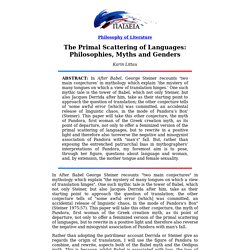
Lilith. By Alan G.
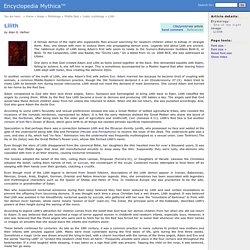
Hefner A female demon of the night who supposedly flies around searching for newborn children either to kidnap or strangle them. Also, she sleeps with men to seduce them into propagating demon sons. Legends told about Lilith are ancient. The rabbinical myths of Lilith being Adam's first wife seem to relate to the Sumero-Babylonian Goddess Belit-ili, or Belili. One story is that God created Adam and Lilith as twins joined together at the back. In another version of the myth of Lilith, she was Adam's first wife before Eve. Adam complained to God who then sent three angels, Sanvi, Sansanvi and Semangelaf, to bring Lilith back to Eden. Radha Shyama. Abarim Publications - Patterns in the Bible. — Everything you know about it is wrong — Welcome to Abarim Publications The name Abarim belongs to a mountain or mountain range in Moab from which Moses viewed the Promised Land from afar (Numbers 27:12).
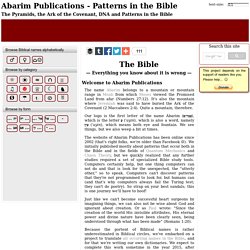
It's also the mountain where Jeremiah was said to have buried the Ark of the Covenant (2 Maccabees 2:4). Quite a mountain, therefore. Our logo is the first letter of the name Abarim (עברים), which is the letter ע ('ayin), which is also a word, namely עין ('ayin), which means both eye and fountain. The website of Abarim Publications has been online since 2002 (that's right folks, we're older than Facebook ☺). Just like we can't become successful heart surgeons by imagining things, we can also not be wise about God and ignorant about creation.
Because the portent of Biblical names is rather underestimated in Biblical circles, we've embarked on a project to translate all occurring names in the Bible, and for that we're writing our own dictionaries. Lailah. The angel Lailah or Laylah (Hebrew "night") is an angel of the night in some interpretations in the Talmud and in some later Jewish mythology.
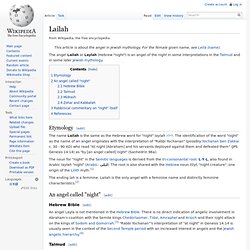
Etymology[edit] The name Lailah is the same as the Hebrew word for "night" laylah לילה. The identification of the word "night" as the name of an angel originates with the interpretation of "Rabbi Yochanan" (possibly Yochanan ben Zakkai c. 30 - 90 AD) who read "At night [Abraham] and his servants deployed against them and defeated them” (JPS Genesis 14.14) as "by [an angel called] night" (Sanhedrin 96a).
Purusha. Contemporary interpretation by artist Igor Kufayev, Purusha, 1995, tondo, oil on canvas, diameter 80 cm, London, private collection.
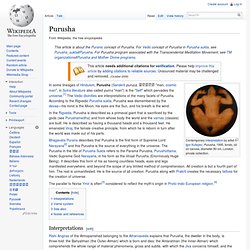
Bhagavata Purana describes that Purusha is the first form of Supreme Lord Narayana[2] and this Purusha is the source of everything in the universe. The Purusha in the title of Purusha Sukta refers to the Parama Purusha, Purushottama, Vedic Supreme God Narayana, in his form as the Viraat Purusha (Enormously Huge Being). It describes this form of his as having countless heads, eyes and legs manifested everywhere, and beyond the scope of any limited method of comprehension.
All creation is but a fourth part of him. The rest is unmanifested. The parallel to Norse Ymir is often[3] considered to reflect the myth's origin in Proto-Indo-European religion.[4] Interpretations[edit] The Vedanta Sutras state janmādy asya yatah, meaning that 'The Absolute Truth is that from which everything else emanates' Bhagavata Purana [S.1.1.1]. Varna system[edit] See also[edit] Fiat Lux. Hindusim.